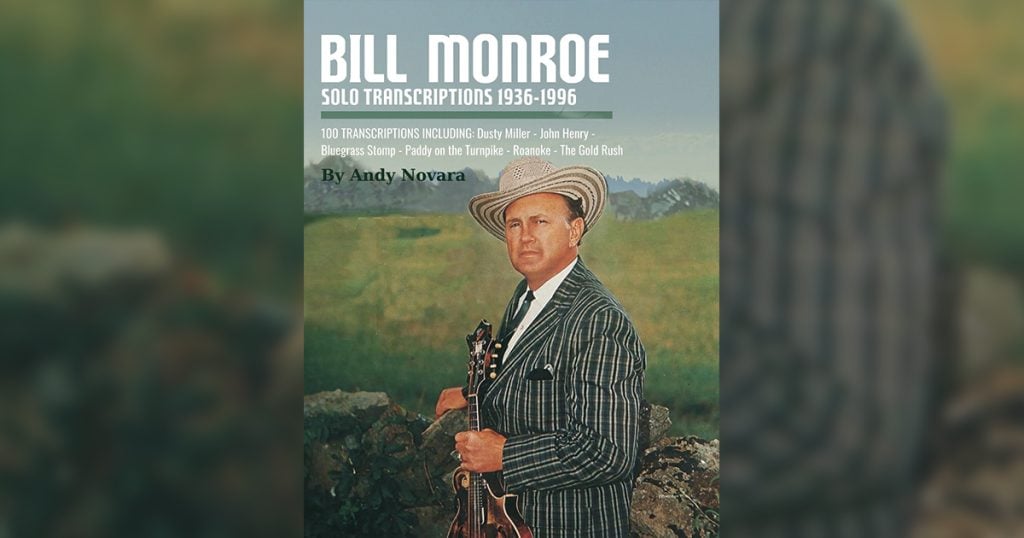Bill Monroe: Solo Transcriptions 1936-1996
By Andy Novara
With the publication of his new book, Bill Monroe: Solo Transcriptions 1936-1996, Andy Novara has added a wonderful and valuable new reference book for students of Bill Monroe’s mandolin style.
The mandolinist in a band called Riverbend, Novara is a skilled Monroe stylist. He clearly adores and has bonded with Monroe’s unique mandolin playing that set the bar for all future bluegrass mandolinists. The product of a near-lifelong study of Big Mon’s style, Novara has meticulously transcribed Monroe licks and tunes by hand, keeping his work in “about 25 notebooks,” he says.
But turning the notebooks of licks and transcriptions into a useful print book requires considerable time and help. As Novara painstakingly entered his hand-written tabs into music notation software, he refined and rethought how to present the music. “What I’ve learned from this project is that this is a never-ending process of fine tuning,” he writes in the introduction. To be even more sure of his work, Novara reached out to serious Monroephiles and former Bluegrass Boys for critiques and double-checks. Novara cites assistance from the esteemed Mike Compton, whose pegheadnation.com video course is ground zero for serious Monroe students. Bobby Hicks also aided Novara’s quest to understand Monroe’s early ‘50s instrument cuts “and the correct way to play them.”
Physically, Novara’s book is spiral-bound, making it easy to use on a music stand. The transcriptions, presented in crisp digital fonts, include both notation and tab. Novara notes that Monroe always said he thought his music could never be captured accurately on paper, and that could be a drawback here. Aside from indicating slides in the tab, this book doesn’t go into topics like pick direction, fingering and more on how Monroe actually played these tunes. But that’s why Novara encourages students to find and listen heavily to the source recording for each transcription first to learn to “hear” what the notes on the page can’t deliver.
The 156-page book is a treasury of carefully rendered transcriptions of Monroe’s solos, from “Ashland Breakdown” to “Why Did You Wander.” It includes all the well-loved Monroe standards including “Monroe’s Hornpipe,” “Brown County Breakdown,” “Rawhide,” “Road to Columbus,” and many more. More interesting to mandolinists already schooled in the Monroe style will be the transcriptions of Monroe’s solos on more obscure tunes like “Put My Rubber Doll Away” from Mr. Bluegrass, and “Blue Goose” from Bluegrass Memories.
Seeking to document the differences between how Monroe recorded a tune versus his live versions, Novara cleverly pairs transcriptions of “Wheel Hoss” from Bluegrass Instruments familiar to many, followed by a transcription of a live version documented on Monroe’s Live Recordings 1956-1969.
This reviewer considers the project could have been improved if Novara had provided more info on where his transcriptions can be found on record, like “No One But My Darling,” taken from Bill Monroe, Decca #9-30809. For example, most like “Brown County Breakdown” and “Wheel Hoss,” are clearly labeled as done from the LP version of Bluegrass Instrumentals and other well-known LPs and recordings with no label numbers provided. Those are easy to find. But many others are from less well-known sources. I found myself wishing every record had been listed by label number, like he did on his transcription of “When You Are Lonely,” which is labeled clearly as Columbia #20526. He explains that most of these tracks were found in the various Bear Family Monroe CD box sets. But given that not everyone owns those expensive, comprehensive box sets, and Monroe’s vast discography and the countless reissues and compilation sets, I would have liked to see Novara cite that information for every tune here.
Small quibbles aside, Novara’s book delivers a significant contribution to the Monroe-style mandolin canon that may become THE reference work until Mike Compton delivers his hyper-accurate book of transcriptions he’s slaving over (“This stack puts me up to ‘Happy On The Way.’ The first of the H’s, with lots more to go,” Mike recently posted on social media.).
Available now for $35 direct via Novara’s website (www.andynovaramusic.com/books), Bill Monroe: Solo Transcriptions 1936-1996 instantly becomes a must-have reference book for any true bluegrass mandolinist eager to take a deep dive into the vast oceans of Bill Monroe’s music. Highly recommended.
www.andynovaramusic.com

